

DEJA-VU : DOUBLE FEATURE PRESENTATION AND ITERATED LOSS IN DEEP TRANSFORMER NETWORKS Andros Tjandra 1* , Chunxi Liu 2 , Frank Zhang 2 , Xiaohui Zhang 2 , Yongqiang Wang 2 , Gabriel Synnaeve 2 , Satoshi Nakamura 1 , Goeffrey Zweig 2 1) NAIST, Japan 2) Facebook AI, USA * This work was done while Andros was a research intern at Facebook
Motivation • Make feature processing adaptive to what is being said. • Different feature processing, depending on what words need to be differentiated in light of a specific utterance. • To achieve this, we allow a Transformer Network to (re)-attend to the audio features, using intermediate layer activations as the Query. • Imposing the objective function on the intermediate layer ensures that it has meaningful information – and trains much faster. • Net – using these two methods lowers error rate 10-20% for Librispeech and Video ASR datasets.
Review: Self-attention in Transformers Transformer module Multihead Self Attention Dot Product Attention Image ref: Attention is all you need (Vaswani et al., NIPS 2017)
Review: VGG + Transformer Acoustic Model ℒ ��� 𝑄, 𝑍 Loss function is either CTC Softmax or CE (for hybrid DNN-HMM) ℒ �� 𝑄, 𝑍 Transformer … Stack of Transformer layers Transformer Blocks of 3x3 convolution + stride (for sub-sampling Mel-spectral) VGG
Problems? • Stacking more and more layers has empirically give better result. • Computer vision: AlexNet (<10 layers) -> VGGNet (20 layers) -> ResNet (>100 layers). • However, training such deep models are difficult. • With improvements in this paper, we can reliably train up to 36 layer networks.
Idea #1: Iterated Loss 𝑎 �� ℒ 𝑄 �� , 𝑍 • In the deep neural network, the loss are always the furthest node from the Transformer input. … • Early nodes (layers) might received less Transformer feedback (due to vanishing gradients). • We add auxiliary loss in the 𝑎 �� 𝜇 ∗ ℒ 𝑄 �� , 𝑍 intermediate node. Transformer 1 Auxiliary layer �� � �� to project 𝑎 to … prediction 𝑄 � (removed after Transformer ����� � � � training finished) ��� 𝑎 �
Effect of Iterated Loss • Comparison: • Baseline 1 CTC (24) • 2 CTC (12–24) • 3 CTC (8-16-24) • 4 CTC (6-12-18-24) • Coeff
Effect of • = 0.3 vs 1.0 • = 0.3 consistent better compared to 1.0 on 2 CTC and 3 CTC
Idea #2: Feature Re-presentation 2 … Transformer combines input • After the iterated loss, we want to feature and Transformer hidden state dynamically integrate the input � � 𝑎 � 𝑎 �� features. Linear Proj + LayerNorm • Why? Transformer • The layer after iterated loss might have 𝑎 �� partial hypothesis. • We could find correlated features based Transformer on the partial hypothesis. … • There are several ways we have explored (next slide -> ) Transformer 𝑎 �
(Cont.) Feature Concatenation 𝑎 ��� • (Top) Feature axis. concatenation Transformer Linear proj. + LN Q K V � 𝑎 � � 𝑎 � • (Btm) Time axis. Concatenation ✓ best performance • Split A : input as Query Split A Split B • Split B : hidden state as Query 𝑎 ��� 𝑎 ��� Time Cat + Post Projection Transformer Transformer Q K V Q K V � � Z � � � � � Z � 𝑎 � 𝑎 � 𝑎 � 𝑎 �
𝑎 �� ℒ 𝑄 �� , 𝑍 Final architecture Transformer 2 … Transformer combines input feature and Transformer hidden state � � 𝑎 � 𝑎 �� Linear Proj + LayerNorm Transformer 𝑎 �� 𝜇 ∗ ℒ 𝑄 �� , 𝑍 Transformer 1 Auxiliary layer to project 𝑎 to … prediction 𝑄 (removed after Transformer training finished) 𝑎 �
Result: Librispeech (CTC w/o data augmentation) Model Config dev test clean other clean other CTC Baseline VGG+24 Trf. 4.7 12.7 5.0 13.1 + Iter. Loss 12-24 4.1 11.8 4.5 12.2 12% test-clean & 8% test-other relative improvement 8-16-24 4.2 11.9 4.6 12.3 6-12-18-24 4.1 11.7 4.4 12.0 20% test-clean & 18% test-other + Feat. Cat. 12-24 3.9 10.9 4.2 11.1 relative improvement 8-16-24 3.7 10.3 4.1 10.7 6-12-18-24 3.6 10.4 4.0 10.8
Librispeech with data augmentation Model Config LM test-clean test-other CTC (Baseline) VGG+24 Trf. 4.0 9.4 Without iter-loss & feat-cat , + Iter. Loss 8-16-24 4-gram 3.5 8.4 increasing Transformer layers + Feat. Cat 8-16-24 3.3 7.6 doesn’t improve performance With iter-loss & feat-cat , CTC (Baseline) VGG+36 Trf. 4.0 9.4 we still get improvement with deeper Transformer + Iter. Loss 12-24-36 4-gram 3.4 8.1 + Feat. Cat 12-24-36 3.2 7.2
Librispeech with hybrid DNN-HMM Model Config LM test-clean test-other Hybrid (Baseline) VGG+24 Trf. 3.2 7.7 9% test-clean & + Iter. Loss 8-16-24 4-gram 3.1 7.3 12% test-other improvement + Feat. Cat 8-16-24 2.9 6.7
Video dataset Model Config video curated clean other CTC (Baseline) VGG+24 Trf. 14.0 17.4 23.6 + Iter. Loss 8-16-24 13.2 16.7 22.9 + Feat. Cat 8-16-24 12.4 16.2 22.3 CTC (Baseline) VGG+36 Trf. 14.2 17.5 23.8 13% curated 8% clean + Iter. Loss 12-24-36 12.9 16.6 22.8 6% other + Feat. Cat 12-24-36 12.3 16.1 22.3 improvement Hybrid (Baseline) VGG+24 Trf 12.8 16.1 22.1 9% curated 4% clean + Iter. Loss 8-16-24 12.1 15.7 21.8 3% other + Feat. Cat 8-16-24 11.6 15.4 21.4 improvement
Conclusion • We have proposed a method for re-processing the input features in light of the information available at an intermediate network layer. • To integrate the features from different layers, we proposed self- attention across layers by concatenating two sequences in time-axis. • Adding iterated loss in the middle of deep transformers helps the performance (tested on hybrid ASR as well). • Librispeech: 10-20% relative improvements • Video: 3.2-13% relative improvements
End of presentation Thank you for your attention
Recommend
More recommend